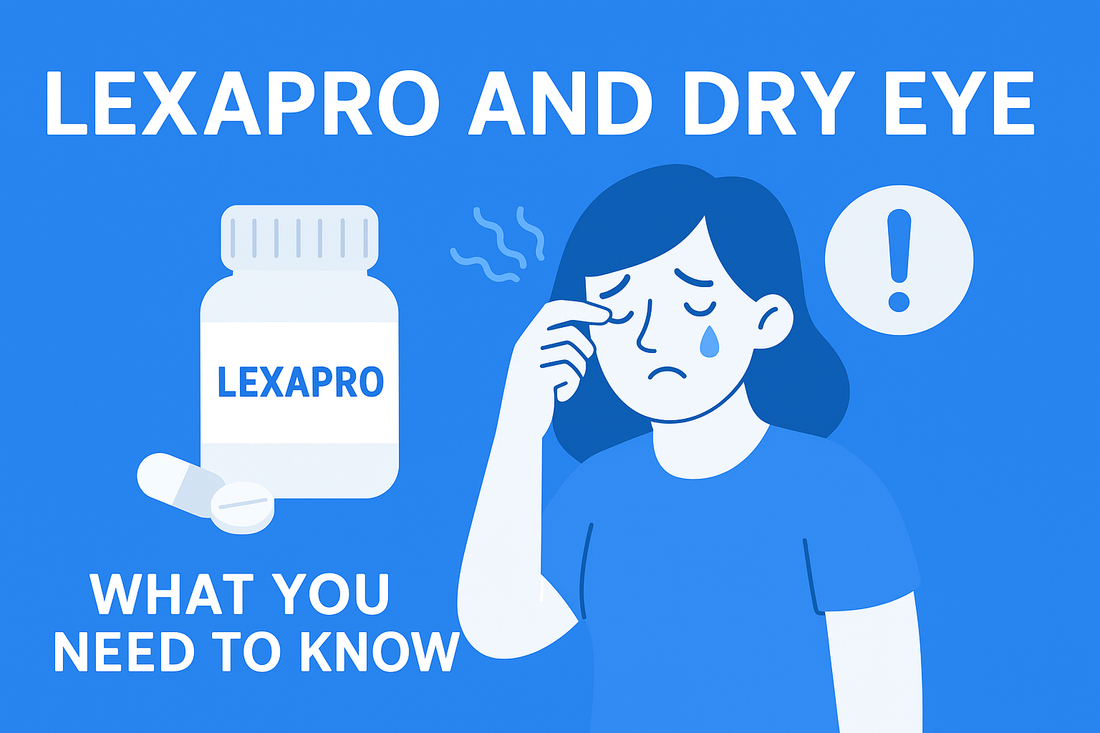21 million people are prescribed Lexapro for depression, generalized anxiety disorder, or other mood-related conditions. When you see this drug on the patient questionnaire, do you immediately think to ask the patient if they have dry eye symptoms?
Studies suggest that 30% of patients on Lexapro experience dry eye symptoms - particularly women and contact lens wearers. You really should be aware of this and ask the question
“How do your eyes FEEL?” This is not a vision question. It is a dry eye and discomfort question.
What is Lexapro
Lexapro (generic name: escitalopram) is one of the most commonly prescribed antidepressants in the world. As an SSRI (Selective Serotonin Reuptake Inhibitor), it’s used to treat depression, generalized anxiety disorder, and other mood-related conditions. While Lexapro is generally well tolerated, one often-overlooked side effect is its potential to cause or worsen dry eye disease.
How Does Lexapro Work?
Lexapro is an SSRI, which works by increasing serotonin levels in the brain. This helps regulate mood, emotion, and anxiety. It’s widely prescribed because it has fewer side effects compared to older antidepressants like tricyclics or MAO inhibitors.
However, SSRIs don’t only affect the brain. They also interact with serotonin receptors found throughout the body, including in the eye.
Why Does Lexapro Cause Dry Eye?
There are two primary mechanisms behind SSRI-induced dry eye:
1. Reduced Tear Production
SSRIs like Lexapro reduce the parasympathetic nervous system’s activity. This system helps stimulate tear secretion. When it’s suppressed:
-
Lacrimal glands produce fewer tears
-
Tear film becomes unstable
-
Eye surface dries out
2. Changes in Mucin and Lipid Layers
Newer studies suggest that SSRIs may alter the composition of the tear film:
- Reduced mucin production from goblet cells
-
Potential meibomian gland dysfunction (oily layer deficiency)
Together, these effects disrupt the tear film’s three-layer structure, leading to dry, irritated, and inflamed eyes.
How Common Is Dry Eye with Lexapro?
-
Reported dry eye incidence in SSRI users ranges from 10% to 25%, depending on dose, duration, and patient population.
-
Women, older adults, and contact lens wearers are at higher risk.
-
Some clinical studies have found that SSRIs increase dry eye risk by up to 30% compared to non-users.
-
Escitalopram (Lexapro) is specifically mentioned in post-market reports as one of the more commonly implicated SSRIs.
In many patients, dry eye symptoms appear within weeks of starting Lexapro and can persist or worsen over time.
How Many People Take Lexapro?
-
In the United States, Lexapro is consistently among the top 10 most prescribed psychiatric medications.
-
According to IQVIA prescription data and CDC estimates:
-
Over 21 million prescriptions for escitalopram were filled in the U.S. in 2023.
-
An estimated 8 to 10 million unique patients are treated with Lexapro annually in the U.S. alone.
-
Over 21 million prescriptions for escitalopram were filled in the U.S. in 2023.
-
Worldwide usage is even higher, as escitalopram is on the WHO List of Essential Medicines.
With this large population base, even a modest dry eye risk translates to millions of people potentially affected.
What Can You Do If You Have Dry Eye from Lexapro?
If you suspect your dry eye is linked to Lexapro, here are some steps to consider:
1. Talk to Your Doctor
Never stop taking Lexapro without medical guidance. There may be alternatives like sertraline or bupropion that carry less ocular risk.
2. Start Artificial Tears or Ointments
Preservative-free lubricating drops are often the first line of defense. We recommend Optase Dry Eye Intense or Systane Complete PF. If you are a contact lens wearer, try Optive Mega-3.
3. Use Warm Compresses & Lid Hygiene
Especially if you have meibomian gland involvement. We recommend our Peeq Pro Facial and Eyelid Cleanser and our Warm Compress. But, hypochlorous acid is also a good choice - particularly if you wear false eyelashes.
4. Try Omega-3 Supplements
Some evidence suggests they may help stabilize the tear film.
5. See an Eye Specialist
A dry eye evaluation can help identify the type and severity of dry eye - aqueous-deficient vs. evaporative. Not every doctor treats dry eye, so it is essential that you find someone who specializes. This is a critical step.
Conclusion
While dry eye may seem like a minor side effect, for many Lexapro users it can become chronic, frustrating, and even disabling, affecting screen use, sleep, and quality of life.
The key is awareness and early intervention. If you’re on Lexapro and noticing symptoms like burning, tearing, or gritty eyes, don’t ignore them. Speak with your healthcare provider and consider an ophthalmic evaluation.

